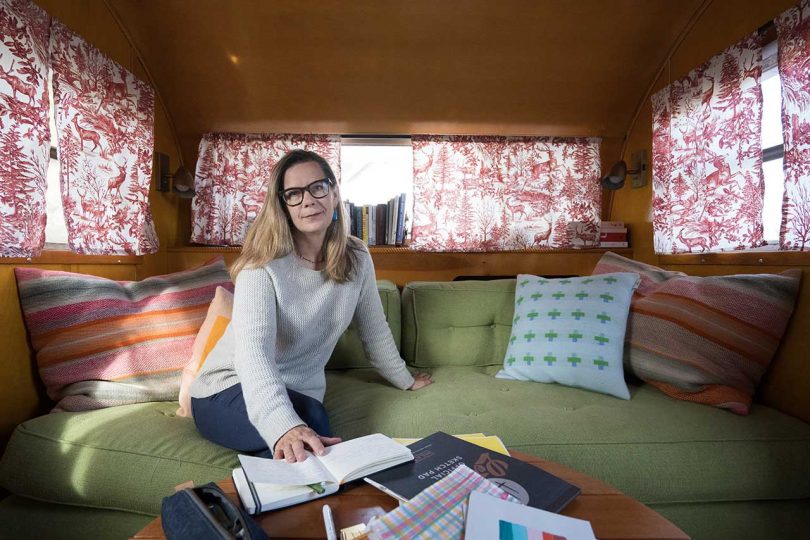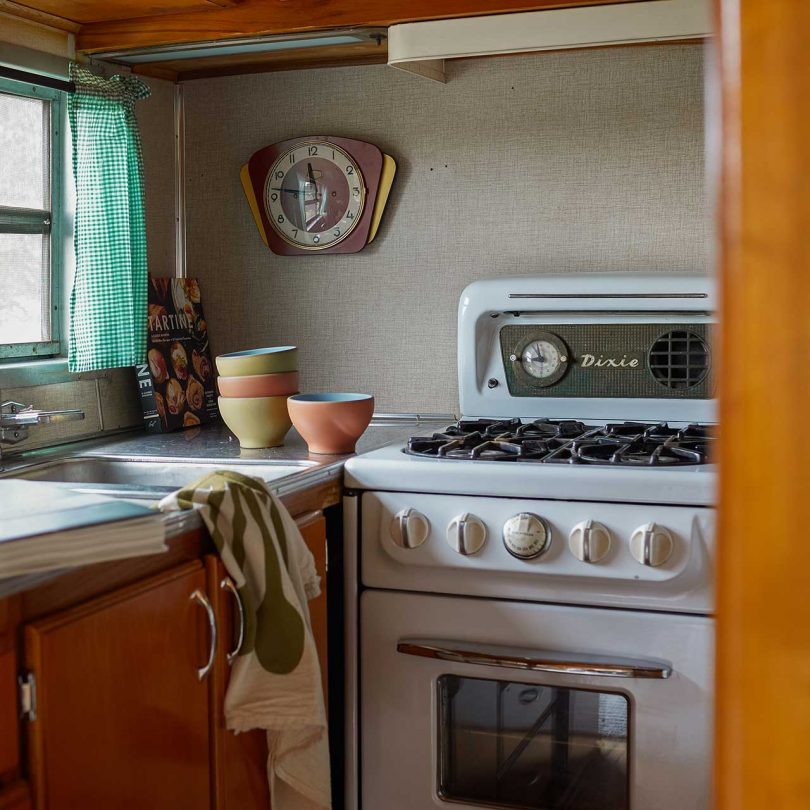A lot has changed since Heath Ceramics co-founder Catherine Bailey appeared on the Clever podcast earlier this year. A complete shift in how and where she works was necessary, as it has been for many people around the world. Instead of staying put at home, she moved to her property in West Marin, California in March to set up a simpler life and work existence in two vintage trailers. Despite its picturesque waterside location, Bailey finds herself more productive than ever having less distractions popping up throughout the day. For this month’s Where I Work, Heath creative director Catherine Bailey fills us all in on the business in the time of a pandemic, where she’s working, and how she’s getting it all done.
What’s your studio/work environment like?
So much is shifting, and just like everything else changing, and so has my work environment. My work requires me to meet with many different people at Heath. I look at physical objects, glazes, and products that must be seen and held to understand. A small but favorite part of my work is exploring my own ideas through painting and drawing, but most of my work is communicating with co-workers, through physical and digital conversations. Before Covid-19, I spent much of my work day in different meeting rooms and offices. My office, complete with our dog Ponch, was where I started and ended the day, and sometimes got some emails done. All creative work happened at home, in my office, or at the dining table, depending on the light and my mood.
Since March, when any of us who could work at home did so, I changed homes. I have been spending most of my time working out of a trailer in West Marin. I find this environment gives me perspective, helps me focus, and I can free my head to be creative here. It’s a simpler place, on the water, and in-between doing my work, I’m able to be outside. In this surrounding, we have several different spaces that work for us. We’ve got two trailers, a 1948 and a 1951 Spartanette, and we built a large deck to connect them. I work in one and sleep in the other. There’s also a cottage that’s in need of renovation (not just to make it prettier, but most would consider it a tear down shack) and can function as another space that I can work in. There’s also a picnic table where I can work outside. I’m happiest outside, and in this set up, I’m constantly outdoors, going between one space and the other. My family is often here as well, and the trailers allow us to be in separate contained spaces when we need to focus on our work independently.
How is your space organized/arranged?
I have my digital workspace set up in our 1948 Spartanette trailer. As makeshift as it is, it’s one of the most successful spaces I’ve worked in. The trailer has a built-in table, and I work on an old Aalto stool. I never work straight for more than 45 minutes. I need to get up, stretch, leave the trailer, and step outside. Getting outside so often gives me perspective, the small windows in the trailer create the perfect light for screen work, and since the space is independent, no one is passing through or distracting me. I’m so efficient in getting things done! I’ll also move locations a lot. I take video calls in the work trailer or sometimes in the cottage. Work in the evening can extend into the sleeping trailer. The trailers don’t have lots of storage space built in, so I don’t have years of accumulated stuff in this current work space, which feels freeing.
How long have you been in this space? Where did you work before that?
I’ve been working this way as much as I can since late March. I go into our Sausalito Factory to see and discuss samples, but other than that, I am doing all my work at the trailers.
If you could change something about your workspace, what would it be?
I really miss large work tables that foster collaboration and discussion!
Is there an office pet?
Ponch – as is Jon and Ponch… think 1980’s TV, Eric Estrada… he’s the best trailer office dog. In the regular office, he has a “jumping on people” problem.
Do you require music in the background? If so, who are some favorites?
I listen to a lot of audio books if I’m doing work that doesn’t require writing, most recently Utopia for Realists and The Nordic Theory of Everything. For music Rosanne Cash and Wilson Pickett have been on my playlist this month.
How do you record ideas?
Notebook with specific organization. A 6×6 notebook with heavy paper and a .005 felt tip.
Do you have an inspiration board? What’s on it right now?
I do inspiration documents in Google slides, that are specific to projects.
What is your typical work style?
It’s more haphazard than I’d like it to be. So much of my job is to support others and help them move forward. I’m constantly getting distracted by new fires to help put out, and it doesn’t allow me to often get into the flow of work that I find satisfying. Working out of the trailer is helping me be more focused when I dig into a project. Every day is different. Especially working an hour away from Heath, I have to plan trips into Sausalito or San Francisco in advance. What I love about working here is the weight and rhythm of nature – it is hitting me in the face all day and giving me a sense of rhythm that I never have had in my work life before. Two tides go out every day. Certain birds seem to have rhythm’s that I’m beginning to notice. I have a greater awareness of the connection of where the sun and shadows are to the time of day. It sounds strange, but it helps me organize my day and have more perspective as I wade through some of the most difficult conversations and decisions that are coming up at this time when so much certainty has disappeared.
What is your creative process and/or creative workflow like? Does it change every project or do you keep it the same?
There is consistency in my approach. I always try to look outside for what I know well for inspiration.
What kind of art/design/objects might you have scattered about the space?
The trailers themself are wonderful self-contained design objects, so being able to live in and around them is thought provoking and fulfilling. The exteriors are sheet aluminum and the interiors are made of wood. Walls, floors, ceilings. Lots of ⅛” ply. It’s a lightweight object for what it is, with materials that feel solid on the outside and warm on the inside. The lighting in the 1951 trailer is original and perfect, better than in my house. It’s sort of nice to be in this little bubble of nice design without having to add much, there’s not much space for art or additional objects, other than a few vintage paint-by-numbers paintings that I found at a garage sale years ago, and some ceramics from our studio.
What tool(s) do you most enjoy using in the design process?
Watercolors, they force you to be loose and I find that helpful at the beginning part of the process.
Let’s talk about how you’re wired. Tell us about your tech arsenal/devices.
Nothing terribly unique, I have a MacBook Pro, but working on presentations and photo editing on my huge iMac monitor is a dream.
What design software do you use, if any, and for what?
Not much! I do a lot of photo editing in Lightroom, and some drawing in Illustrator, but other than that, it’s all in Google – lots of Google slides to share inspiration, ideas, plans, and schedules. Especially now when we’re not meeting in person, finding ways of sharing and organizing is important. By taking photos of sketches, or mocking up super rough photos or ideas and collecting them in these documents, the work can be shared and others can contribute.
Personally, I love working on ideas for environments using Sketch Up, I build sloppy models, but they can serve as immersive napkin sketches.
What’s on your desk right now?
Some color explorations for the winter seasonal collection and my little notebook.
Is there a favorite project/piece you’ve worked on?
The Chez Panisse dinnerware we did with Alice Waters is one of my favorite projects. We recently re-released it with new glazes, and I am really happy with the end result and the collaboration. The dinnerware shapes pull from tradition, but are modern, relevant, and functional and the glazes are uniquely Heath. With this project, we are able to support the Edible School Yard. This organization was started by Alice Waters to create and sustain organic gardens in public school’s curriculum, culture, and food programs. The project felt successful on many levels.
Tell us about a current project you’re working on. What was the inspiration behind it?
This is a tough question to answer honestly at this moment. This year has been so hard, so many of the projects we’ve worked on and dreamed about have been delayed or cancelled. We were doing some beautiful work with Alabama Chain, which was going to come out this summer. That was postponed, our team and our factory is smaller due to Covid-19, and this all has an impact on the creative work that is the heart of Heath, and everyone at Heath. Our lead designer, and most of our product development team, was on temporary leave when it was time to decide if we would be able to do a new collection for Winter. Our studio director, Tung Chang, and I decided we would tackle it. We were also in the unfortunate position to have to lay off part of our team, so there were mountains of unknowns. We plowed forward, and are excited about the collection’s inspiration: Hope and Love. The feelings that those words evoke are the season, and override the normal inspirations and filters of winter. We just photographed it, so I cannot show the final result, but these are some of our tests and samples – look for it in October.
Do you have anything in your home that you’ve designed/created?
I designed the interior of my home, as well as this whole trailer indoor-outdoor work life situation that I’m now living in. The space has a bigger vision than these two trailers and the platform connecting them, but being forced to live in an uncompleted vision has made me ask questions about what is necessary and what is enough. There is a certain amount of perfection and detail in design that can sometimes make things better, but not always, and it should be questioned.
To shop Heath Ceramics products, visit heathceramics.com. If you’re looking for more tabletop ideas, visit the Design Milk Shop here!
from WordPress https://connorrenwickblog.wordpress.com/2020/07/28/where-i-work-catherine-bailey-of-heath-ceramics/
















No comments:
Post a Comment